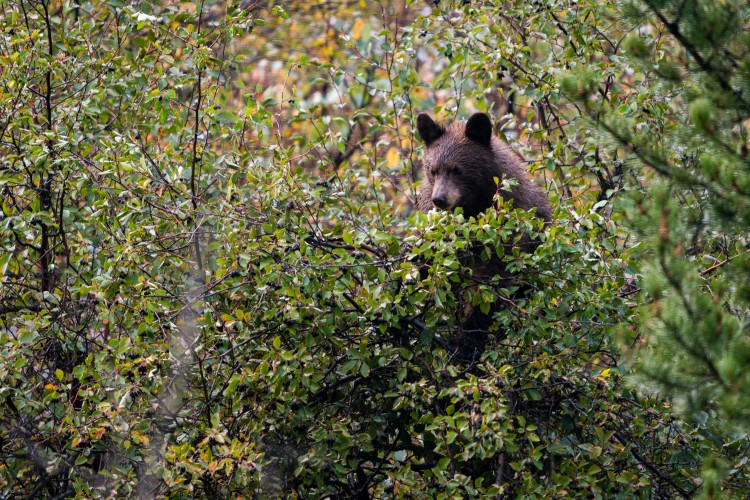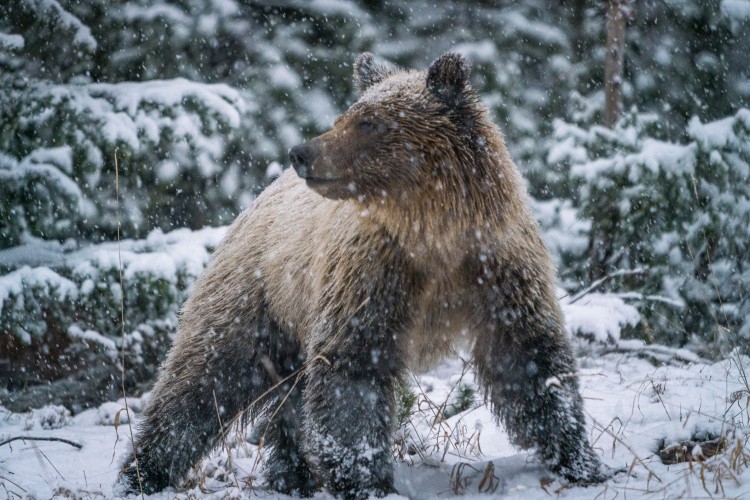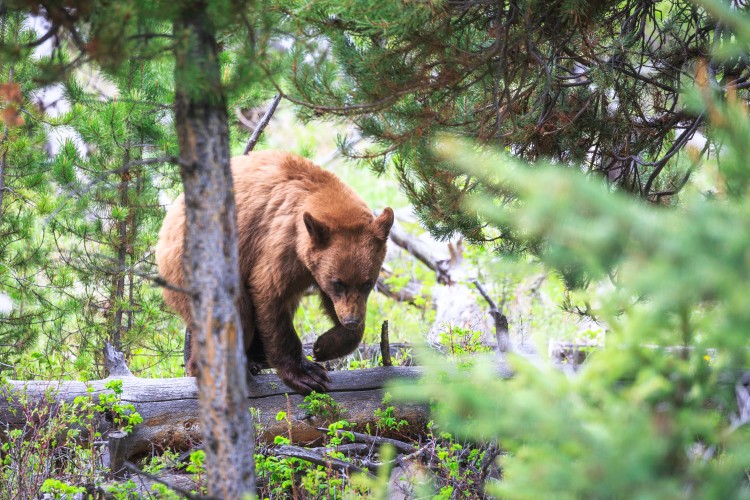What Happens During Bear Hibernation?


Spring is officially here, which means we are beginning to see changes in wildlife populations in Jackson Hole. More specifically, we’re starting to have bear sightings in Grand Teton National Park again! With the warming temperatures, the long winter slumber of bears comes to an end.
Well, it’s not really a slumber, contrary to popular belief! Let’s dig a bit more into bear hibernation, shall we?
Here in the Greater Yellowstone Ecosystem, we have black bears and grizzly bears, and both species hibernate in the winter, although the word “hibernate” is used loosely. Many biologists consider bear hibernation to not be a true hibernation, as the bears are quite alert in their dens. Instead, they enter a “light” hibernation known as torpor. They maintain a body temperature that is close to normal–dropping to between 86-95°F (30-35°C), which is only a small departure from their normal body temperature of 100°-101°F (37.7°-38.3°C). This enables them to react quickly to danger as they do not need to wait for their body to warm up first.

A young grizzly stands in a late spring snowstorm, 2021. Photo courtesy of Josh Metten.
By contrast, mammals that are considered true hibernators, such as squirrels and chipmunks, drop their body temperature by dozens of degrees, entering a state of “deep freeze” that nearly matches the outside winter temperatures. They must wake every few days to raise their body temperature and meet basic needs–eating, drinking, urinating, and defecating.
Bears don’t eat, drink, urinate, or defecate while in their dens. Rather, they live off the layer of fat they spent the summer and fall building up. Instead of urinating, bears recycle their waste. Urea, the waste product in urine produced during the metabolization of fat, is fatal at high levels to all animals. However, bears have the unique ability to break down urea and reabsorb the resulting nitrogen, which they then use to build protein. This enables them to maintain their muscle mass during hibernation, an incredible adaptation! Over the course of winter hibernation, bears may lose between 15-30% of their body weight, but most of that is fat.
What about poop? Bears do not defecate in their dens; instead, they form a fecal plug–made of feces, dead intestinal cells, and hair, among other material–that blocks their colon and prevents them from making a mess in their dens. This plug is expelled when bears emerge from their dens in the spring. Who knew that bears could be so tidy?

A cinnamon black bear walks over a log in Grand Teton National Park. Photo courtesy of Josh Metten.
It’s clear that bears have some amazing adaptations to get them through a long winter without food, water, or bathroom breaks. Did you know that females also give birth while hibernating? Although bear mating season runs from May through July, eggs do not implant in the female’s uterus until December. Gestation is only 6-8 weeks long, and cubs weigh less than a pound when they are born. The cubs spend the rest of winter nursing from their mother and growing quickly. When they emerge from their dens at three months old, black bear cubs weigh between 4-8 pounds and grizzly cubs weigh between 10-20 pounds.
The timing of bear hibernation depends largely on the weather, particularly the snow conditions. Movement toward dens usually begins anywhere from late October to late November, although warming winter temperatures and delays in winter snowfall have been pushing this back. In the fall/early winter of 2020, our famous Grizzly 399 was seen traveling to her den on New Year’s Eve! In the fall of 2021, however, she was last seen in mid-November.
In the spring, male bears are typically the first to emerge, anywhere from late February to late March, and females with cubs are the last to emerge, usually between mid-April and mid-May. In fact, the first grizzlies of 2022 were spotted in Grand Teton National Park in the first week of March!
With this in mind, it’s important to be bear aware when you visit the park. Travel in groups, carry bear spray, and make noise. If you’re traveling here for grizzly sightings, the northern section of the park tends to see more bear activity from March-June, specifically the areas of Pilgrim Creek, Oxbow Bend, and Willow Flats. Remember, many animals are most active at dawn and dusk, so plan accordingly. The drive to northern Grand Teton takes about an hour from downtown Jackson.
We hope to see you out and about in the Tetons this spring, enjoying all the changes that come to the valley with the changing seasons. We’re excited for more bear sightings, and we hope you’ll join us for a wildlife safari tour of Jackson Hole!
To learn more about hibernation and denning behavior in bears, head here.
Written by Kelsey Wellington. Kelsey is a Naturalist Guide with ETA and holds an MFA in Creative Writing from Lindenwood University.













